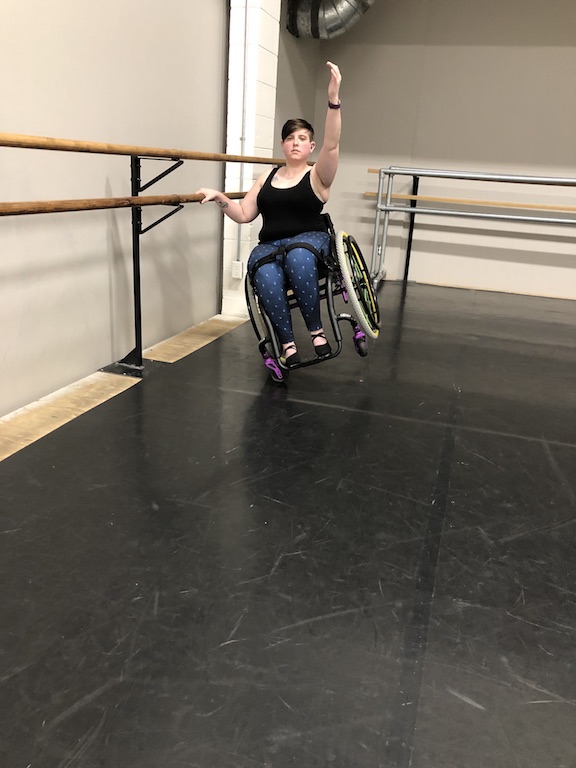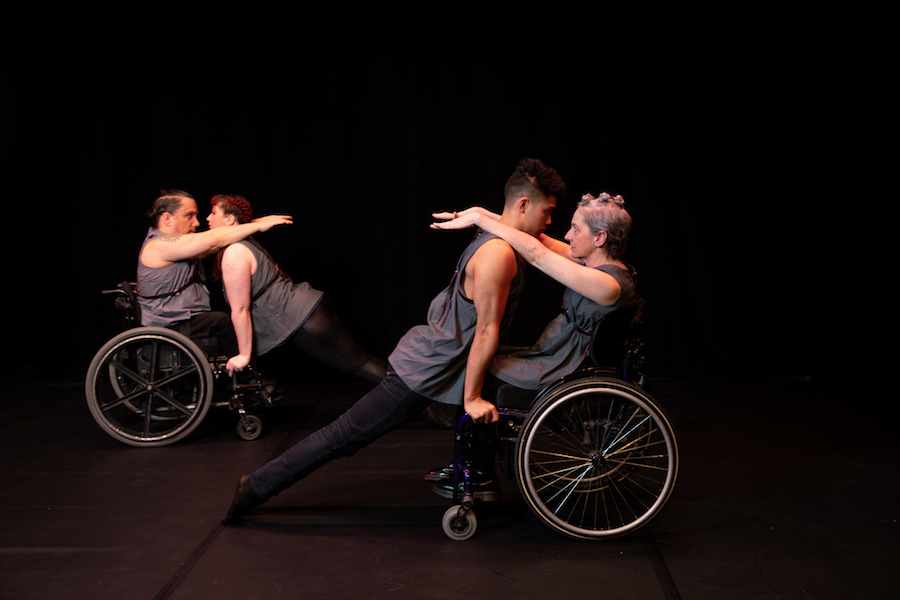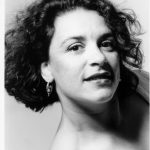ELIZABETH WINKELAAR: Dancer and artistic associate, Propeller Dance Company
I have been dancing with Propeller Dance in Ottawa since I was in my late thirties. I was studying disability art and intersectionality, et cetera, and I was going crazy trying to understand it all. So, I started dancing with an integrated dance group to gain some body knowledge.
Within a fairly short time, I was asked to join the company and I have devoted myself to dance ever since. When I started dancing at least three days a week, I would tell people, “I am a professional dancer.” Sometimes, people found that confusing, but it gave me a chance to talk about the work. I spent a lot of time understanding and exploring the potential of integrated dance work.
I learned that it can be great to challenge who belongs on the stage and whose body is seen as interesting or attractive. I also learned that audiences really love to see something completely new and surprising. I am starting to create choreography fairly late in my career. For me, as a paraplegic woman who had her first career in teaching, it’s extremely important to my identity to speak as a dancer. As my career has progressed, I’ve had more and more chances to network with more mainstream dancers. This access has been very important to me in understanding myself as a dancer.

ABIGAIL THOMAS: Emerging bharatanatyam dancer in Grade 9
Yes, I call my myself a dancer. I see myself as an emerging bharatanatyam artist who is expanding her learning in dance. I began my dance journey at age six, and it was only after two years of training that I truly began to fall deeply in love with the art. Through its intense expressions, I have learned to express myself, finding a way to relate my own life experiences to each character I am depicting. Dance to me is a way to stay connected to my cultural roots.
In the process of making work for Thyaga Panchakam, my guru, Smt. Preetha Kandanchatha, and I visited several artists to seek their blessings, and I was introduced as the “solo dancer.” It was then that I realized how dance has become an integral part in my life. All the artists who I met and worked with viewed me as a dancer. This part of me is slowly developing. Experiencing the effort that goes into presenting the art professionally allowed the dancer in me to emerge. Up until this point, I was a daughter, sister and student, but now I identify myself as a dancer as well.

TRISTAN GINGER: Burlesque performer
I don’t call myself a dancer. I feel I don’t have the years of dance experience and training to call myself a dancer. But I have a love for music and have clocked in many years performing to music onstage. I think I have musicality. I am able to move to the music, to find moments. And most of all, I am able to tell a story and to share a mood through my performance. The only time I would maybe use the term “dancer” is to someone outside of the dance/ burlesque industry.
I think also why I have a hard time with the word dancer is because of imposter syndrome. I don’t feel as skilled or maybe as talented as other performers out there, but I need to remind myself that I am successful. And burlesque is how I make my living. And a good reminder as I go along this journey is that it’s a common feeling. Even the people you look up to have feelings of inadequacy.
So even though I don’t call myself a dancer, I can still put on a damn good show!

CHARMAINE HEADLEY: Co-founder and artistic/executive director, COBA, Collective of Black Artists
I started calling myself a dancer when I realized that dance fed my soul. Unbeknownst to many I was shy and very self-conscious up to my mid-twenties. Dance allowed me to say physically what I was unable to say verbally. I realized it opened and assisted me to navigate spiritual, social, cultural, academic as well as physical spaces and realities. I found my voice, and I have found me, in and through dance. I have been a dancer for over thirty years.

LAUREN RUNIONS: Contemporary dancer, choreographer and educator
I call myself a dancer, but I also identify as a facilitator, choreographer, urbaner and educator.
For as long as I can remember, I have felt shy about introducing myself as a dancer. I can recall many, many incidents of colleagues introducing me to new friends with “This is Lauren. She’s a dancer.” Imagine two eyebrows lifting while delivering the title. I began collecting these statements as tiny affirmations because for some silly reason I did not believe it myself. This went on for a couple of years upon graduating my studies. Now, there was a turning point. This is something I cannot pinpoint in the form of a date or time. However, as I met more like-minded people and continued to speak of what I think in a day, my habitual mapping of felt and spatial pleasures, my curiosity of urban embodiment and ungendering spaces as mindful understandings part act of healing/part art form, I have finally concluded: I try to be in my body. She is a dancer.

ADRIANNA YANUZIELLO: Founder and artistic director, Dance Migration
I am a dancer, yes. But I am also much more than just that. It’s funny to me because growing up I always danced and always looked at myself as a “dancer,” but I wasn’t sure exactly what that meant.
When I travelled to Brazil in 2006, I discovered what dance was for me. Dance is a tool that connects me to the universe and aligns me with spirit. Through this knowing, dance has opened many doors in my life. It has connected me to the whole world and has offered me a space to dive into myself as a human being. Through being a “dancer,” I have discovered so many other skills that I hold and how I dance inside them all.
Dance is a means of inspiration and that is my mission – to share it with the public or anyone that meets me on this journey.

SUJIT VAIDYA: Bharatanatyam dance artist
I haven’t consciously thought about this question. Also, I am hesitant to label myself as one thing. To call myself a dancer seems to discredit the various hats one wears as a dance “professional” – another loaded word. As an independent dance artist, I am my own manager, publicist, grant writer, sometimes funder and programmer. I might have strongly identified as a dancer in the earlier part of my dance career when I was making the transition from dance student to getting paid to dance. But as I started creating and curating my own work, my definition of what I do has expanded to beyond a “dancer.”
I think that in some capacity I have always identified as a dancer, even before formally training to be one. The very first time I saw a performance in bharatanatyam, something sparked within me and I remember trying to recreate the steps. In fact, the joy of dance that I experienced in this utterly non-technical zone still stays with me, and I remind myself to try and feel that space when I get too caught up in the technical aspects of dancing. Somehow, when my body responded to the rhythms of the mridangam (drum), I knew that I had a special connection with dance and I felt like a dancer. As my relationship with dance started to deepen, this identity started to feel unidimensional, but it is the one constant in everything that I do. Whatever life throws my way, I find myself thinking like a dancer.

MIRANDA LIVERPOOL: Samba dancer and teacher
Yes, I call myself dancer. I did this when I was four years old, running around a gymnasium with scarves in my hands and pink ballet slippers on my feet and while quietly standing upright at a barre in first position while the children around me talked, fidgeted and pulled at their leotards.
I called myself a dancer all through middle and high school, heading to classes at night while doing homework in the car and turning down invitations to social outings on the weekends because I had rehearsal and competitions.
I called myself a dancer in university, commuting to school every day on the train to start classes at 8am. One year, my teacher looked me in the eye and said, “You are a dancer.” It wasn’t because of my physical ability but because of the essence of my movements and the heart that went with it.
I called myself a dancer when I performed every night in the middle of the ocean, when I hopefully handed in my resumé at auditions, when I bowed during standing ovations, when no one came to watch, even when I feared how I would pay the bills. I remained a dancer.
I identify as a dancer because it’s who I am. It’s not just my job; it’s my passion. It’s not just what I can do; it’s what I feel. And long after I step off the stage, it will still be true.

MIKHAIL MORRIS: Dancehall dancer, choreographer and artistic director
Five years ago, I would have considered myself as a professional dance artist, but currently that title/status has changed to artistic director (international cultural ambassador) for Jamaica. Since I am the co-owner of my own production company called KETCH DI VYBZ, which focuses on creating a platform for dancehall theatre production, lecturing/teaching workshops, videography and photography and event planning, I use these skills to create art that showcases and educates about the culture of the African diaspora.
I started to identify as a professional dancer many years ago when I was sixteen and decided I wanted dance to become a career. I was awarded a dance scholarship to attend the Edna Manley College of the Visual and Performing Arts in Jamaica. I was trained in classical ballet, modern, contemporary dance and traditional folk dances. After I graduated, I came to Canada in January 2010 to pursue my career working with different professional dance companies.

MARISSA WONG: Co-director, TWObigsteps Collective
Rather than it being a personal choice, the identity of a dancer was given to me in high school, when I was dancing intensely. There is an assumption of commitment and professionalism that is associated with that title. However, its simplicity can provide limitations based on the other person’s knowledge of this art form. Presenting myself as a dance artist does not always encompass the versatile skill set beyond just dancing, including choreographing, teaching and running TWObigsteps Collective. When conversation and time permit, I enjoy sharing my individual experience and expressing the diversity this career can take form in.
I currently support myself solely through dance; however, there was a period where I was not training or working in the dance community. During this interval, I grappled with my identity as a dancer and realized how it defined me since childhood. I strive to connect, share and challenge my assumptions through communication. My attachment to the identity of a dancer shifted as I realized this goal can appear in many forms. For now, it has led me to express through movement.

SHAY ERLICH: Contemporary dancer, performer and writer
I identify as a wheelchair dancer because dance frequently reinforces that there is a specific body and movement type that is preferred and that anything less is unacceptable. What I do in my wheelchair and in my non-compliant body runs the risk of not being seen as dance unless I remain adamant that what I do is dance and is just as deserving of this label as other dance forms.
I used this label from the beginning. As my career has developed, there are moments where I notice that my use of the word becomes less about the politics and more about my understanding of myself as a dancer. When I saw professional images of myself moving, it became harder to deny that I was a dancer; my embodiment and presence in the moment was markedly different from my day-to-day demeanour.
Another defining moment was recognizing that I was making sacrifices in my daily life to be in studio, participate in training and perform in productions. Noticing this commitment reinforced for me that I was consistently choosing to be a dancer when other choices would have been easier. And finally, how I feel when I am onstage dancing is the thing that convinces me I am a dancer more than anything else: the world melts away and becomes secondary, dancing in a moment that seems like it could stretch on forever yet is over far too soon. To me, this moment – where I am more present than anywhere else – is why I am a dancer.






